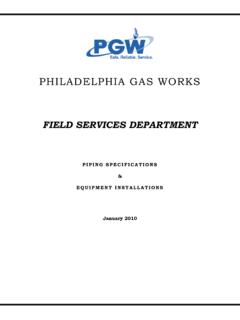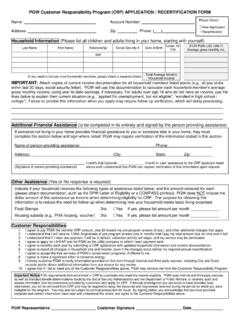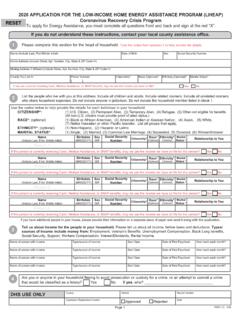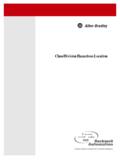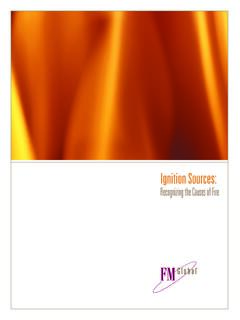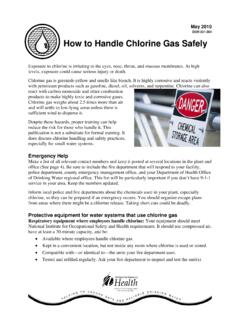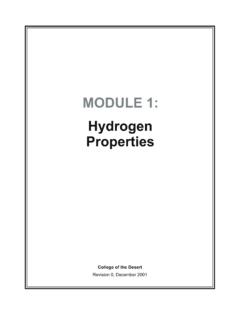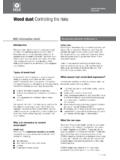Transcription of Safety Data Sheet: Liquefied Natural Gas (LNG)
1 Safety data sheet : Liquefied Natural Gas (LNG) Section 1: Identification Product Name: Liquefied Natural Gas SDS Number: 2015001 Synonyms/Other Means of Identification: LNG, Liquid Methane, Natural Gas Refrigerated Liquid Intended Use: Fuel Manufacturer: Philadelphia Gas Works (PGW) 800 W. Montgomery Avenue Philadelphia, Pennsylvania 19122 (215) 684 6774 Emergency Health and Safety Number: CHEMTREC: (800) 424-9300 Manufacturer Health and Safety Contact: PGW Safety Manager: (215) 684 6554 Manufacturer Technical Information Contact: PGW Chemical Services: (215) 787 4850 Section 2: Hazard(s) Identification Classification/Hazard Category flammable Gases Category 1 Gasses Under Pressure Refrigerated Liquefied Gas Note: Under the United Nations Globally Harmonized System of Classification and Labeling of Chemicals (GHS), the lower the hazard category number, the greater the hazard, and the higher the hazard category number, the less severe the hazard. Pictograms Signal Word DANGER Hazard Statements Extremely flammable gas.
2 (H220)* Contains refrigerated gas; may cause cryogenic burns or injury. (H281)* 2015001 Liquefied Natural Gas SDS US Issue Date: 06/01/2015 Page 1 of 11 Precautionary Statements: Do not use or handle unless all Safety precautions have been read and understood. (P202)** Keep away from heat, hot surfaces, sparks, open flames, and other ignition sources, including internal combustion engines. No smoking. (P210)** Take action to prevent static discharge, including static discharge from cell phones and other electronic devices. (P243)** Wear cold insulating gloves, a cold insulating apron, eye protection, and face shield. (P282)** If exposed to liquid, seek immediate medical attention. (P315)** Eliminate all ignition sources if safe to do so. (P381)** Limbs affected by frostbite may be thawed with lukewarm water. Do not rub affected area. See immediate medical attention. (P336)** Do not extinguish fires from leaking gas unless leak can be stopped safely. (P377)* Store in a well ventilated space.
3 (P403)** Use only non sparking tools. (P242)** * Applicable GHS Hazard Code. ** Applicable GHS Precautionary Statement Code. Supplementary Hazard Information: High concentrations of LNG vapors may displace oxygen, especially in a confined space. LNG and its vapors do not exhibit the characteristic odor of Natural gas. Containers of LNG are typically under pressure and temperature controlled conditions; These containers may explode if heated or if temperature control is not maintained. Section 3: Composition/Information on Ingredients Liquefied Natural gas (LNG) is a cryogenic liquid derived from Natural gas by processing. LNG consists primarily of methane and ethane; the table below identifies the components in LNG that may be present in concentrations of 1 percent or more by volume. For health and Safety determination purposes, the LNG composition listed in the table below represents the widest range of components observed in the LNG produced and stored by PGW based upon the results of sample analysis conducted between 2010 and 2015.
4 The following constituents may also be present in LNG at concentrations less than 1 percent by volume: iso butane, normal butane, pentanes, hexanes, heavier hydrocarbons (C6+), and nitrogen. Component Name Synonyms Chemical CAS Number Concentration Formula (% Volume) Methane Methyl hydride, CH4 74 82 8 67 97 marsh gas, carbane Ethane N/A C2H6 74 84 0 3 29 Propane N/A C3H8 74 98 6 0 4 2015001 Liquefied Natural Gas SDS US Issue Date: 06/01/2015 Page 2 of 11 Section 4: First Aid Measures Eye Contact: Contact with product may cause frostbite. In case of frostbite or freeze burns, gently soak the eyes with cool to lukewarm water. DO NOT WASH THE EYES WITH HOT WATER ( over 105oF). Open eyelids wide to allow liquid to evaporate. If the person cannot tolerate light, protect the eyes with a bandage or handkerchief. Do not introduce ointment into the eyes without medical advice. Seek immediate medical attention. Skin Contact: Contact with product may cause frostbite. In case of frostbite or freeze burns, remove contaminated clothing and flush the affected area with cool to lukewarm water.
5 Immediately place frozen area in a circulating warm water bath or in flowing warm water (100 to 105 oF). DO NOT USE HOT WATER ( over 105oF) OR DRY HEAT. Seek immediate medical attention if blistering, tissue freezing, or frostbite has occurred. Under no circumstances should the frozen part be rubbed, either before or after warming. Inhalation (Breathing): Inhalation of large quantities of LNG vapors may cause central nervous system depression with nausea, headache, dizziness, vomiting, and incoordination. LNG and associated vapor is a simple asphyxiant and may cause loss of consciousness, serious injury, or death by displacing air, thereby resulting in insufficient oxygen to support life. Prompt medical attention is strongly recommended in all cases of inhalation overexposure. Rescue personnel should be equipped with a self contained breathing apparatus. Remove inhalation victims to fresh air quickly. If inhalation victim is not breathing, ensure that their airways are open and administer cardiopulmonary resuscitation (CPR).
6 If necessary, have a trained person administer air or oxygen once breathing is restored. Seek immediate medical treatment. WARNING: The burning of any hydrocarbon as a fuel in an area without adequate ventilation may result in hazardous levels of combustion products, including carbon monoxide, and inadequate oxygen levels, which may cause loss of consciousness, serious injury, or death. Ingestion (Swallowing): This material is a gas under atmospheric temperature and pressure conditions and ingestion is unlikely. Seek immediate medical attention if material is ingested. Section 5: Fire Fighting Measures Fire Fighting Instructions LNG vapors are extremely flammable and can be ignited by heat, sparks, flames, static electricity, and other sources of ignition, such as pilot lights, mechanical/electrical equipment, and electronic devices that are not intrinsically safe. Vapors may travel considerable distances to a source of ignition where they can ignite, flash back, or explode.
7 Vapors may accumulate in confined spaces. LNG fires should not be extinguished unless the source of the leak can be stopped safely. In most cases, it is best to eliminate the source of the leak and allow the liquid to burn off. Isolate 2015001 Liquefied Natural Gas SDS US Issue Date: 06/01/2015 Page 3 of 11 the spill or leak area, particularly around the ends of storage vessels, and maintain a safe distance upwind and uphill of the spill or leak area. Let the vessel, tank, or container burn unless the leak can be stopped. LNG is stored under pressure and temperature controlled conditions; containers of LNG exposed to excessive heat or flame may rupture violently and suddenly without warning due to vessel over pressurization. Fragmentation of the container should be anticipated. Withdraw immediately in the event of a rising sound from a venting Safety device. Use water fog and/or deluge to cool equipment, surfaces, and containers exposed to fire and excessive heat. Do not direct water at the source of the leak, pooled LNG, or Safety devices; the indiscriminate use of water on surfaces of cryogenic containers and piping can lead to heavy icing, causing excessive loads on structures and the failure of valves, instrumentation, and other control devices.
8 Application of water to pools of LNG will cause the LNG to vaporize more rapidly, generating more gas to feed a fire or create a larger vapor cloud . For large fires, use unmanned hose holders or monitor nozzles to minimize personnel exposure. Appropriate fire extinguishing media include dry chemical, carbon dioxide, halon, and high expansion foam. While water may be used to cool equipment and structures adjacent to an LNG fire, water is not an appropriate extinguishing media when responding to LNG fires as water can increase the volatilization of the LNG or cause ice formation as described above. Avoid allowing water runoff to contact spilled materials, and do not allow LNG or runoff from firefighting activities to enter drains or water courses as the runoff may create an explosion hazard. Large fires typically require specially trained personnel and equipment to isolate and extinguish the fire. Hazardous combustion products include smoke, carbon monoxide, carbon dioxide, and other products of combustion.
9 Oxides of nitrogen may also form. LNG storage installations may be equipped with high expansion foam systems that protect LNG storage areas by quickly blanketing liquid LNG in the event of spill, which helps to control vapor release. High expansion foam is also used to extinguish fires; total flooding of the area of spilled LNG with high expansion foam limits the amount of oxygen required to support free combustion and provides a slow, continuous release of foam solution for cooling and vapor suppression. Consult LNG facility personnel regarding available onsite spill control, fire suppression, and firefighting systems. Refer to Section 8 for Exposure Controls/Personal Protection and refer to Section 9 for flash point and flammability limits (explosive range). Refer to Section 16 for the National Fire Protection Association 704 Hazard Rating. Section 6: Accidental Release Measures In case of an accidental release, activate your facility's spill contingency plan, if available.
10 Evacuate non essential personnel and secure all ignition sources. Do not allow road flares, smoking, cell phones, or other sources of ignition in the hazardous area. Internal combustion engines generate sparks that would serve to ignite LNG vapors, so do not drive vehicles through the vapor dispersion area, and do not attempt to start vehicles that are within the vapor dispersion area. Do not touch spilled liquid (frostbite/freeze burn hazard!), and avoid contact 2015001 Liquefied Natural Gas SDS US Issue Date: 06/01/2015 Page 4 of 11 with any surface cooled by LNG vapor or liquid. Evaluate wind direction and speed to determine the direction of product travel. The vapor cloud may be white, but the color will dissipate as the cloud disperses; however, the fire and explosion hazard is still present! Stay upwind and uphill, if possible, and avoid low lying areas. Test the area for hazardous atmospheres before re entering. Stop the source of the release, if safe to do so. Do not flush the product down the sewer or drainage systems as it may create an explosion hazard in these confined spaces.

